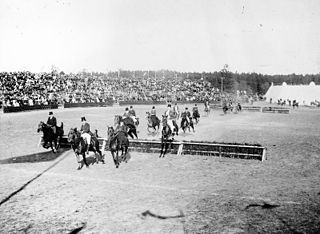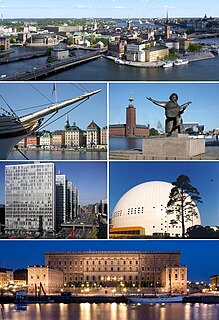Football at the 1912 Summer Olympics was one of the 102 events at the 1912 Summer Olympics in Stockholm, Sweden. It was the fourth time that football was on the Olympic schedule. The tournament was contested between 11 nations, all of them from Europe, with Great Britain winning the gold medals. Replicating the 1908 tournament, Denmark won silver medals and the Netherlands won bronze medals.
Goudi Olympic Complex is a sports complex in Athens, Greece. It held two of the sports venues used during the 2004 Summer Olympics.

Liljeholmen is a district of the Hägersten-Liljeholmen borough in Söderort, the southern suburban part of Stockholm.

Stockholm Olympic Stadium, most often called Stockholms stadion or simply Stadion, is a stadium in Stockholm, Sweden. Designed by architect Torben Grut, it was opened in 1912, its original use was as a venue for the 1912 Olympic Games. At the 1912 Games, it hosted the athletics, some of the equestrian, some of the football, gymnastics, the running part of the modern pentathlon, tug of war, and wrestling events. It has a capacity of 13,145–14,500 depending on usage and a capacity of nearly 33,000 for concerts.

Hammarbyhöjden is a suburban city district in Stockholm, Sweden. The district is split across two boroughs: Most of it is located in Skarpnäck borough, the subdistrict Blåsut is located in the Enskede-Årsta-Vantör borough. As of December 31, 2007, Hammarbyhöjden had 8,143 inhabitants.

Russian Empire (Russia) competed at the 1912 Summer Olympics in Stockholm, Sweden. 159 competitors, all men, took part in 62 events in 15 sports.

Austria competed at the 1912 Summer Olympics in Stockholm, Sweden. Austrian and Hungarian results at early Olympic Games are generally kept separate despite the union of the two nations as Austria-Hungary at the time. 85 competitors, 76 men and 6 women, took part in 46 events in 12 sports.

Italy competed at the 1912 Summer Olympics in Stockholm, Sweden.

Finland competed at the 1912 Summer Olympics in Stockholm, Sweden. The Grand Duchy of Finland was part of the Russian Empire at the time, but Finland's results are kept separate from those of Russia. In the Opening Ceremony Finland's team paraded under the national insignia flag of a Swedish-speaking female gymnastics club in Helsinki. 164 competitors, 162 men and 2 women, took part in 49 events in 10 sports.
Tranebergsbron is a double arch bridge in central Stockholm, Sweden. Stretching over the strait Tranebergssund it connects the major island Kungsholmen to the western suburb Bromma. It has a road and also metro tracks.
Barkarby is a district of Järfälla Municipality, Stockholm County, Sweden and part of the contiguously built-up Stockholm urban area.

Djurgårdsbrunnsviken is a bay in central Stockholm, Sweden, together with the canal Djurgårdsbrunnskanalen forming the northern shore line of the island Djurgården. The bridge Djurgårdsbron stretches over the bay.
IK Göta is a Swedish sports club, which was very successful in several sports such as Track & Field, Team Handball, Bowling, Field Hockey, Ice Hockey ice hockey, Soccer and Bandy during the 20th century. Most famous and successful sport was Ice Hockey. They won the Swedish ice hockey championship nine times, including the inaugural championship in 1922. The club was also operating bandy teams, both women's and men's, winning the Swedish Men's championship in bandy once, in 1927. In women's bandy they were far more successful winning eight (8) times, last time in 1984.

Pirita is a subdistrict in the district of Pirita, Tallinn, the capital of Estonia. It is located around the estuary of the Pirita River to the Tallinn Bay. The subdistrict has a population of 960. Pirita was selected as the venue of the sailing events for the 1980 summer Olympics. During the preparations for the Olympics, sports buildings were built in Tallinn including the Pirita Yachting Centre and the Hotel Olümpia.

Östermalms IP is a sports ground located in the Östermalm district of Stockholm, Sweden. Completed in 1906, the facility played host to several sports during the 1912 Summer Olympics. These sports included equestrian, fencing, and tennis. It also hosted the exhibition for baseball at those same games. Current tenants are the bandy department of Djurgårdens IF, the youth program of the said club's football department and several lower league teams. The athletic grounds also hosts a speed skating rink during winter.

Kaknäs is a former village in Medieval times located in Stockholm, Sweden, as part of the Ladugårdsgärdet area. It is the site of several archeological finds and has given its name to Kaknästornet. During the 1912 Summer Olympics, it hosted several shooting events.
Fältrittklubben or the Stockholm Cross Country Riding Club is an equestrian club located in Stockholm, Sweden, established in 1886 by Prince Carl, Duke of Västergötland. During the 1912 Summer Olympics, it hosted the endurance trials for the equestrian eventing competition.

Lindarängen is a location outside Stockholm, Sweden. During the 1912 Summer Olympics, it hosted the steeplechase trials for the equestrian eventing competition.
The 1945 Swedish Ice Hockey Championship was the 23rd season of the Swedish Ice Hockey Championship, the national championship of Sweden. Hammarby IF won the championship.

Tranebergs Idrottsplats was a football stadium in Traneberg district, western Stockholm, Sweden. It was opened in September 1911. Tranebergs Idrottsplats served as the home ground of Djurgårdens IF for 25 seasons. Stadium was demolished in 1936.















